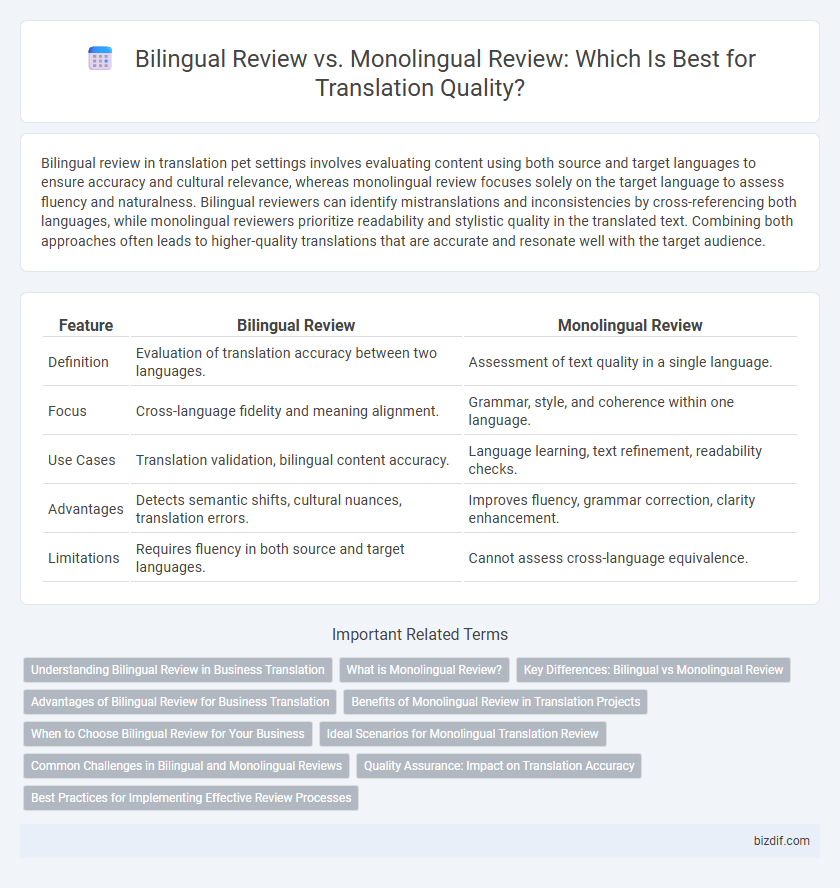Bilingual review in translation pet settings involves evaluating content using both source and target languages to ensure accuracy and cultural relevance, whereas monolingual review focuses solely on the target language to assess fluency and naturalness. Bilingual reviewers can identify mistranslations and inconsistencies by cross-referencing both languages, while monolingual reviewers prioritize readability and stylistic quality in the translated text. Combining both approaches often leads to higher-quality translations that are accurate and resonate well with the target audience.
Table of Comparison
| Feature | Bilingual Review | Monolingual Review |
|---|---|---|
| Definition | Evaluation of translation accuracy between two languages. | Assessment of text quality in a single language. |
| Focus | Cross-language fidelity and meaning alignment. | Grammar, style, and coherence within one language. |
| Use Cases | Translation validation, bilingual content accuracy. | Language learning, text refinement, readability checks. |
| Advantages | Detects semantic shifts, cultural nuances, translation errors. | Improves fluency, grammar correction, clarity enhancement. |
| Limitations | Requires fluency in both source and target languages. | Cannot assess cross-language equivalence. |
Understanding Bilingual Review in Business Translation
Bilingual review in business translation involves comparing the source text alongside the target text to ensure accuracy, consistency, and cultural relevance, which is crucial for maintaining brand messaging across languages. This method allows translators and reviewers to detect subtle errors or nuances that may be missed in monolingual reviews, where only the target language is evaluated. Employing a bilingual review process enhances client trust by delivering precise and contextually appropriate translations in global business communications.
What is Monolingual Review?
Monolingual review refers to the evaluation of translated texts or content by a reviewer fluent only in the target language, ensuring linguistic accuracy and naturalness without cross-referencing the source language. This type of review focuses on grammar, style, and cultural appropriateness within the target language context to optimize the final product for its intended audience. Monolingual reviewers rely on their native language expertise to detect inconsistencies, awkward phrasing, and localization issues that impact readability and comprehension.
Key Differences: Bilingual vs Monolingual Review
Bilingual review in translation involves evaluating content in two languages to ensure accuracy, cultural relevance, and consistency, whereas monolingual review focuses solely on quality, fluency, and correctness within one language. Bilingual review requires proficiency in both source and target languages, enabling comparison and detection of subtle errors or mistranslations that monolingual review might miss. Monolingual review emphasizes language purity, style, and readability without cross-referencing the original text, making it suitable for target audience validation but limited in verifying translation fidelity.
Advantages of Bilingual Review for Business Translation
Bilingual review ensures accuracy by involving native speakers of both source and target languages, reducing misinterpretations in business translation. It enhances cultural relevance and localization, which is crucial for market-specific messaging and customer engagement. This dual-language expertise leads to higher quality translations that align tightly with brand voice and regulatory requirements, maximizing global business impact.
Benefits of Monolingual Review in Translation Projects
Monolingual review in translation projects ensures content accuracy and cultural relevance by engaging native speakers of the target language, which helps identify subtle linguistic nuances and idiomatic expressions often missed in bilingual reviews. This process enhances overall fluency and readability, resulting in translations that resonate better with the target audience. Monolingual reviewers also contribute to maintaining consistent tone and style, increasing the professional quality of the final output.
When to Choose Bilingual Review for Your Business
Choosing bilingual review for your business is essential when targeting a diverse customer base speaking multiple languages, ensuring accurate cultural and linguistic nuances are captured. It enhances product credibility and customer trust by providing precise translations that reflect native expressions and industry-specific terminology. Bilingual review is particularly beneficial for marketing materials, legal documents, and technical content requiring both language proficiency and subject matter expertise.
Ideal Scenarios for Monolingual Translation Review
Monolingual translation review is ideal when the reviewer is unfamiliar with the source language but possesses high proficiency in the target language, ensuring that the translation reads naturally and coherently. This approach excels in quality assessment of stylistic accuracy and cultural relevancy, making it suitable for marketing materials, literary texts, and consumer-facing content. Monolingual review focuses on fluency, grammar, and idiomatic expressions, optimizing the target text for its intended audience without being influenced by source language constraints.
Common Challenges in Bilingual and Monolingual Reviews
Bilingual reviews often face challenges such as maintaining accuracy across languages, cultural nuances, and idiomatic expressions that require deep linguistic knowledge and contextual understanding. Monolingual reviews primarily struggle with terminology consistency, technical jargon, and ensuring clarity and precision within a single language. Both types of reviews demand rigorous quality control to avoid misinterpretation and ensure the translated content meets the target audience's expectations.
Quality Assurance: Impact on Translation Accuracy
Bilingual review involves comparing source and target texts side-by-side, enhancing translation accuracy by ensuring semantic equivalence and cultural relevance. Monolingual review, conducted solely on the target language, focuses on fluency and grammatical correctness but may overlook subtle meaning shifts. Implementing bilingual review in quality assurance significantly reduces mistranslations and preserves the original message's intent.
Best Practices for Implementing Effective Review Processes
Bilingual review in translation ensures accuracy by cross-checking source and target texts simultaneously, enhancing cultural and contextual fidelity. Monolingual review focuses on the target language quality, emphasizing grammar, style, and coherence, crucial for polished final output. Combining both approaches maximizes translation quality, balancing linguistic precision and native readability throughout the review process.
Bilingual Review vs Monolingual Review Infographic

 bizdif.com
bizdif.com